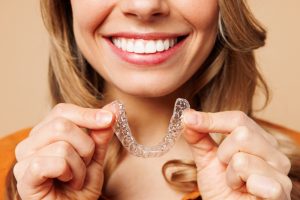If you’ve noticed hard, yellow, or white buildup that won’t brush away, you’re likely seeing what people call calcium deposits. Dentists call it tartar (calculus)—plaque that has hardened and bonded to your teeth.
Once it forms, it can’t be removed at home; only a professional dental cleaning can safely remove it.
At Parkcrest Dental Group, we help patients remove calcium buildup comfortably and prevent it from coming back. In this post, you’ll learn what causes it, how we treat it, and the habits that keep your smile clean and bright between visits.

What Causes Calcium Buildup on Teeth
Plaque is a sticky film of food particles, bacteria, and minerals that forms on your teeth after eating. If it isn’t brushed away, it can calcify within 24–48 hours, forming tartar that clings to the enamel and the gumline.
You may be more likely to develop calcium buildup if you:
- Skip brushing or flossing regularly
- Have crowded or overlapping teeth
- Smoke or use tobacco products
- Drink coffee, tea, or soda often
- Have dry mouth from medications or dehydration
Calcium buildup can appear yellow, tan, or dark brown, while chalky white spots may signal calcium loss (decalcification)—an early warning that enamel is starting to weaken.
How to Get Rid of Calcium Deposits on Teeth
Unfortunately, toothpastes and DIY methods can’t remove hardened tartar—professional tools are required.
At Parkcrest, our hygienists use advanced ultrasonic scalers and gentle hand instruments to:
- Lift tartar from above and below the gumline
- Smooth enamel so plaque has a harder time sticking
- Polish for a clean, fresh finish.
If buildup has irritated your gums, we’ll discuss deeper cleaning and a regimen to restore your gum health.

How to Prevent Calcium Deposits From Coming Back
Keeping tartar away is all about consistency and preventative care. Follow these daily habits for lasting results:
1. Brush and floss daily
Use a fluoride toothpaste and a soft-bristle toothbrush. Replace your brush every three months—or sooner if the bristles spread out.
2. Use fluoride and rinse after meals
Fluoride helps remineralize enamel and fight bacteria. If you can’t brush, rinse with water or chew sugar-free gum to neutralize acids.
3. Keep up with professional cleanings
Even the best home routine can’t reach every spot. Schedule dental exams every six months—or more often if needed.
4. Watch for discoloration
After buildup is removed, teeth may show minor staining or uneven color. Professional whitening can safely brighten your smile.
Calcium Stains vs. Calcium Deposits
It’s easy to confuse calcium stains with calcium deposits, but they’re different—and the right fix depends on which one you have.
Calcium Stains (Decalcification)
These appear as chalky white or light gray patches on the enamel surface. They often develop after braces come off or when acids from food, drinks, or bacteria dissolve minerals in the enamel. While they’re not rough to the touch, they can make your smile look uneven or dull.
At Parkcrest, we treat calcium stains by helping the enamel remineralize—sometimes with fluoride varnishes or cosmetic options, such as ICON White Spot Treatment.
Calcium Deposits (Tartar or Calculus)
These are the hard, rough buildups you can feel with your tongue near the gumline or behind lower front teeth. They form when soft plaque hardens over time and traps bacteria that irritate the gums.
The only way to remove them safely is through a professional dental cleaning, or in more severe cases, a deep cleaning. If calcium deposits aren’t removed, they can lead to gum inflammation, bleeding, and bad breath, eventually progressing to gum disease.

Frequently Asked Questions
No. Brushing and flossing prevent plaque; only a hygienist can remove tartar.
Plaque can start hardening within 48 hours if not removed.
No—whitening brightens color; tartar must be cleaned first.
No. Stains are surface color changes; deposits are hardened buildup that requires professional removal.
Parkcrest Dental recommends cleanings every six months, though some patients benefit from visits every 3–4 months if they’re prone to buildup.
Ready to Restore Your Smile?
If your teeth feel rough or look dull, calcium buildup could be the reason. A quick visit to Parkcrest can restore your shine and keep your mouth healthy. Call us to schedule your cleaning today, or request an appointment online!




